|
|
![]()
FOREST HEALTH - BARK BEETLES AND BORERS - SOFTWOODS
Bark Beetles include over 100 insect species and are among the most destructive in North America. It is estimated that approximately 60 percent of all tree growth loss is due to these burrowing pests. Bark beetles excavate egg galleries in fresh phloem, the inner bark which carries food from leaves to the roots of a tree. When the eggs hatch, hundreds of larvae eat their way from the main gallery, mining the inner bark in all directions. The pattern of their work is like a fingerprint for the species, and their collective eating nearly always spells doom for the tree. The first easily noticed sign of this is a reddening or fading appearance in the top of the tree, followed by complete browning. Less noticeable are patches of pitch or sap seeping out where the insects first entered the trunk. These insects are usually only a problem in mature or maturing trees, or stressed trees, but some species plague young plantations.
Wood borers go deeper than bark beetles, doing their damage in the sapwood and even the heartwood of a tree. But while some wood borers attack living trees, others drill into recently cut logs, lowering their value for lumber or pulp. Some even attack finished lumber. Often the tunnels have a secondary effect of providing an entry point and channels of spread for fungus (rot). Although not true of all species of wood borers, telltale sign is often the sawdust and other wastes that accumulate outside holes in the trunk or limbs. The best defenses against many members of this group are to keep trees healthy, vigorous and undamaged, and to sell or use cut trees quickly rather than letting them lie around. This is especially important during the summer. Common families include the Cerambicids and Buprestids.
| Engraver Beetles Hemlock Borer Horntails Longhorned/Sawyer Beetles Pine Root Collar Weevil |
||
Engraver/bark beetles (Ips spp., Scolytus spp., Dendroctonus spp.): outbreaks can cause widespread mortality, especially among old or stressed trees, often a secondary infestation, Dendroctonus can be more aggressive in healthy trees once an infestation begins, the mountain pine beetle mortality throughout the Rockies is due to Dendroctonus ponderosae |
||
| Hosts: all conifers | ||
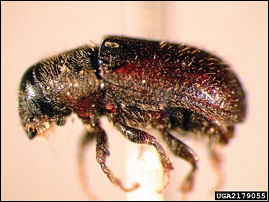 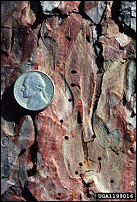 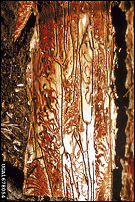 |
||
Hemlock borer (Melanophila fulvoguttata): rarely attacks healthy trees, one of the flat-headed borers, Buprestid family |
||
| Hosts: hemlocks | ||
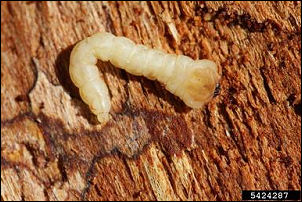 |
||
Horntails (several genera of the wasp family): sometimes rather fearsome looking wasps but they do not sting humans, they attack recently dead or dying trees, females drill into tree to lay eggs, larvae chew tunnels about 3/16 inch diameter with tight-packed borings, Sirex noctilio is an exotic pest of pines (introduced 2004) |
||
| Hosts: most conifers | ||
|
||
Longhorned & Sawyer beetles (Cerambycidae family): many native species of lovely beetles often with very long antennae, rather high freak-out factor for many people, round-headed borer larvae commonly found in logs and dying/dead trees, chewing can be heard in log piles or firewood that have sat around too long, the two-spotted sawyer is sometimes mistaken for the Asian longhorned beetle |
||
| Hosts: all conifers | ||
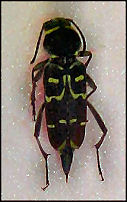 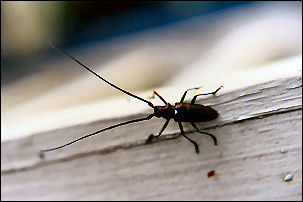 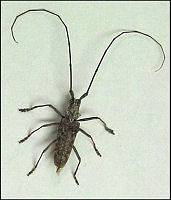 |
||
Pine root collar weevil (Hylobius radicus): attacks base of stem causing trees to die and prematurely fall over, larvae feed at root collar, adults munch on needles |
||
| Hosts: Scots pine, red pine on poor sites | ||
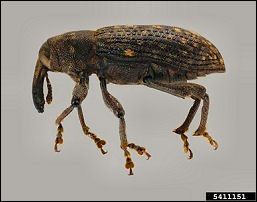 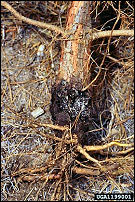 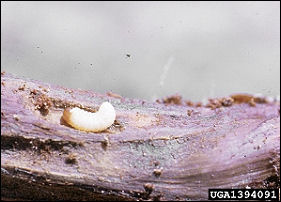 |
||
Image Citations
Engraver Beetle (1) - Darren Blackford, USDA Forest Service, Bugwood.org
Engraver Beetle (2) - Steven Katovich, USDA Forest Service, Bugwood.org
Engraver Beetle (3) - David McComb, USDA Forest Service, Bugwood.org
Hemlock Borer (1) - Steven Katovich, USDA Forest Service, Bugwood.org
Horntail (1) - Sirex noctilio - David R. Lance, USDA APHIS PPQ, Bugwood.org
Pine Root Collar Weevil (1) - Jennifer C. Girón Duque, University of Puerto Rico, Bugwood.org
Pine Root Collar Weevil (2) - Steven Katovich, USDA Forest Service, Bugwood.org
Pine Root Collar Weevil (2) - James B. Hanson, USDA Forest Service, Bugwood.org
All others - Bill Cook, Michigan State University Extension
Click HERE
to return to the U.P. Tree ID home page.
Click HERE to return to the Forest Health home page.
This site created and maintained by Bill Cook, MSU Extension Forester for the Upper Peninsula of Michigan. Editing and modification is ongoing. Submit suggestions, questions, and corrections to cookwi@msu.edu or call 906-786-1575.